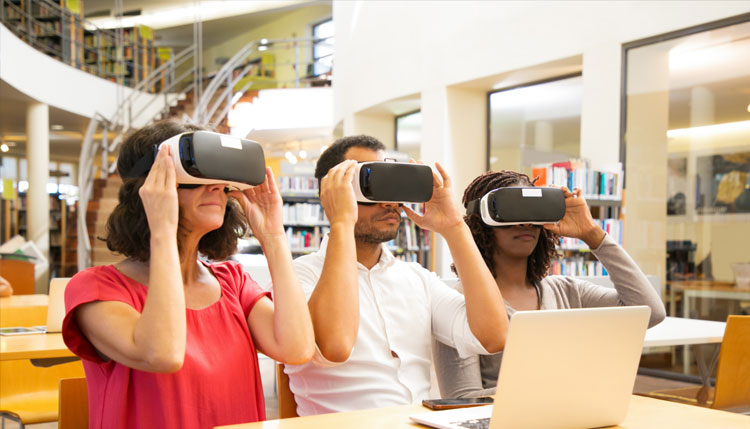
Last updated on February 19, 2025
Creating Engaging Experiences With AR/VR Technology In Media And Gaming
With time, the media and gaming industries need to constantly keep looking for ways to make the experiences they offer more unique and captivating, harder than ever to achieve. It is time for Augmented Reality (AR) and Virtual Reality (VR) to step into the scene, with the ability to change the way audiences interact with content. By 2025, these immersive technologies are no longer a friendly recommendation for industry leaders, they are a non-negotiable aspect if one wants to stay updated and relevant in the industry. This blog discusses the impacts of AR and VR on the media and gaming industry, the challenges that arise, and how companies can take advantage of them.
The Use of AR and VR In Media: Innovative Ways of Telling Stories
The use of AR and VR technologies help create new forms of storytelling that let the audience do more than just view, they can and interact with the content directly.
- Virtual Tours and Web-Based Storytelling
Think of a viewer trying to tell a historical story or diving into an interesting subject of a documentary, just to find out that they have the option of a guided virtual tour. With the help of VR, users can not only watch places and events, but they can also take part in them. This enables the user to feel even more connected to the content. Platforms like Google Arts and Culture have already started using VR technology to offer virtual tours of museums with the intent to engage people across the globe.
On top of this, augmented reality merges the real world with digital content. For example, during a virtual reality event, participants can be provided with extra context, behind the scenes material, or even take part in real time engagement that enhances the event’s experience. Media houses can make use of AR apps for marketing purposes, allowing the customers to interact with the product in a different way.
- 360 Degree Video and Interactive Documentaries
With the development of 360-degree videos, new types of interactive documentaries have also emerged, allowing the audience to navigate around the story in a multitude of angles. The format is capturing the intensity and feelings behind the events, as seen in the works of National Geographic who created VR documentaries that try to solve urgent problems concerning the environment. As more regions come online to 5G networks, these underserved experiences will continually improve, further increasing audience activations.
- VR Gaming Experiences and Hardware Advancements
As technology continues to evolve, the virtual reality gaming world has reached new levels. With cutting-edge devices such as the Meta Quest 3 and the Valve Index, gamers can immerse themselves in fully realized environments. At this level, a player’s sense of determination and the overall emotional experience will cultivate like never before.
Example of such an advancement is the VR rhythm game, Beat Saber. Players engage themselves in physically beating arrows with lightsabers, giving them a chance to work out, compete and enjoy all at once. The blend of physical and social interaction that this game brings is one of a kind.
AR Games and Location-Based Entertainment
Put simply, augmented reality gaming is taking over the world by storm with an ideal example being Pokémon GO. Real world surroundings serve as the stage background as players encounter characters and complete challenges. To add to the uniqueness of this POI, other people get a taste of the game and work with one another for a common purpose.
As the AR world evolves, developers are actively venturing into location-based experiences. Such as, AR can be used to enhance public scavenger hunts by revealing treasures or quests within a specific area, promoting group cooperation and engagement through play.
Obstacles and Approaches – Overcoming the AR/VR Challenges
Despite the alluring prospects of AR and VR, it’s important to deal with various obstacles to make them work successfully in media and gaming.
- Technological Issues
When it comes to AR and VR, latency is an extremely important issue. Even the tiniest of latencies can be problematic due to its connectivity disruption, and could possibly even lead to user discomfort, like motion sickness. Improving user experience involves developing strong systems that reduce latency and promote smooth user interactions.
On top of that, the challenge of creating high-quality, realistic content is ongoing. While advancements in AI are helping streamline this process, the need for skilled creators who can leverage new technologies remains paramount. Companies must invest in talent development and utilize tools that accelerate content creation without sacrificing quality.
- User Accessibility
Many users do seem to struggle securing the required hardware for the ideal AR or VR experience. This barrier proves difficult to overcome. One of the solutions was to explore the variety of cross platform mobile devices on offer and creating AR experiences limited only to smartphone devices.
- Ensuring Content Quality
Audiences and users today are much more sophisticated and therefore demanding better content that captures their attention and provides some value. The media and gaming industry must shift their focus from mass producing games to prioritizing crafting engaging user experiences that users will love and keep coming back for more.
Conclusion: Embracing AR and VR for Future Success
As the gap between gaming and media narrows, leading figures must note the great potential of AR and VR technology and the shifts these experiences bring to the engagement with a brand and an audience. The investment these technologies require is no small ask but for those willing to take the cap, the reward is riveting.
Collaborating with experienced personnel in a specific field can yield good information on how to move within AR and VR’s increasing scope. Blanco Infotech has broad experience in these technologies and offers customized services that allow businesses to realize the full potential of immersive experiences. In the fast-changing market, these organizations can gain extremely competitive advantages by using Blanco’s Infotech capabilities.






